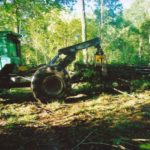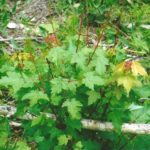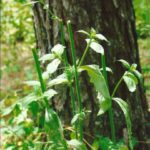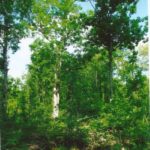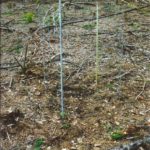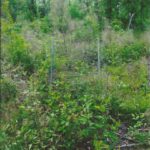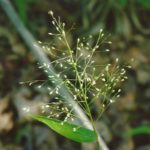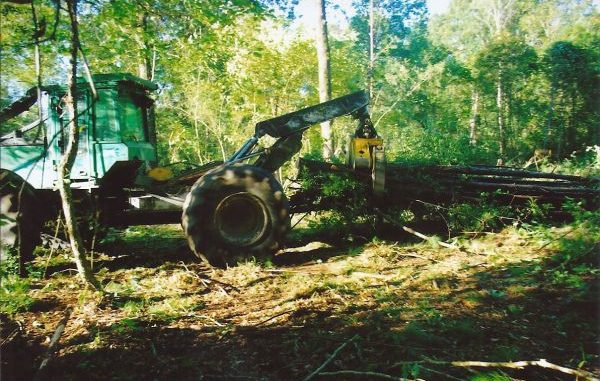
A good old-fashioned clear-cut can do a lot to help feed deer and increase hunting opportunities. Here’s why.
During the mid-1970s, I was conducting a study concerning the flora of Bienville Parish for my master’s thesis at Northeast Louisiana University (now ULM) when I got a glimpse of my first large timber clear-cut.
Just a year before, there was a forest occupying this site, and now only the forest debris remained. It would not be the last time to see such an area. When I went to work for the Louisiana Department of Wildlife and Fisheries a little later in that decade, the demand for wood products was high and the logging industry was going strong.
I remember a field trip with then-state deer biologist Jerry Farrar at that time when I was the district biologist, when we headed out to look at similar logging activities in Washington Parish, where the residents referred to the forests north and south of Highway 10 as the North Pasture and the South Pasture.
Clear-cutting was being done on an extremely large scale, and the hunters were very upset about it.
The removal of hardwood trees has always been a concern of hunters because of their high wildlife value. But timber companies are created to make money, and pine is — or was — the money tree in the South.
The high demand for lumber, probably due to the Baby Boomer Generation coming of age and building their houses, resulted in much logging in this state during the \’70s and \’80s.
While the hunters initially did not like it, they quickly learned that a clear-cut produces lots of green plants that white-tailed deer eat. The result was an explosion of deer across the state, and the annual deer harvest began to increase.
The new habitat created by this logging was a boon for deer populations, and deer hunters soon learned that a clear-cut makes a great location for a deer stand.
With the creation of the 1985 Farm Bill and CRP, logging continued and much of the farm land and pasture land in Southeast Louisiana was planted with pine trees. A good hardwood market in the early \’90s kept the logging crews busy, and we began to see hardwood forests being replaced with pine forests.
The timber companies really began stepping up their silviculture practices, and pines were being bedded and herbicides were sprayed to reduce the competition from hardwood species.
I was the deer biologist for the state by that time, and my phone started ringing again: This time the hunters wanted to know what was going on with their woods — there were no longer deer in the cutovers.
Logging that once produced a new population of deer wasn\’t producing more animals.
Surveys of these sites revealed that the site preparation work was doing an excellent job of controlling the hardwood species deer used as food. The productivity of a clear-cut and the newly planted forest was no longer conducive to deer; hence the deer carrying capacity was reduced, and this resulted in a decline in good deer hunting.
Fortunately, this is not the case on all the piney woods land in Louisiana, but on the commercial timber lands this type of management has become the norm and is one of the main reasons hunters are seeing a decline in deer numbers on their clubs.
As with all wildlife species, habitat is the critical part in maintaining good game populations.
Clear-cutting has long been recognized in the timber industry as an excellent way to regenerate an even-aged forest, even on hardwood tracts.
The native browse that deer eat is a product of habitat and the logging activity applied to the habitat. Forests where available browse is low will benefit from timber cutting and the increased sunlight that increases the growth of browse plants.
Production of new browse in clear-cut stands occurs from stump sprouts and root sprouting. For the first few years, the plant growth has the appearance of a thick jungle of briars and vines; this tangled mass is providing much forage and cover for the deer.
But the intense site preparation and herbicide treatments used today basically kills the sprouts, reducing the growth of deer forage.
Because of public sentiment against large clear-cuts, foresters often take a different approach to forest regeneration, such as using uneven-age regeneration methods.
Another problem today is the lack of logging on private and public land; forest canopies are closing in, resulting in a lowered deer carrying capacity across the state and fewer deer for hunters to hunt.
Small landowners surrounded by larger tracts of private land might not see much benefit in their deer management program if the habitat and deer herds on these larger tracts are not being properly managed.
An old fashioned clear-cut
A good friend of mine purchased a small 60-acre tract of land in the early \’90 in Clinton. This property had been heavily logged prior to him purchasing it, and deer numbers were high.
I help him with the management work on this tract, and we experienced good deer hunting for many years, primarily because food and cover was excellent.
He planted 30 acres or so with pine and, combined with the natural pine regeneration, the tract began closing in. By 2010 there just wasn\’t much native browse in the woods for deer.
We also noticed a major decline in the physical condition of the deer: low body weights and poor antler development.
Surrounding lands are primarily mixed pine/hardwood, and browse is also lacking on these tracts and the deer kill on these lands is low.
We examined deer stomachs in 2011 and found heavy use by deer of privet, yaupon and climbing fern; these species were the common plants in the woods, while other, more-desirable woody species were lacking.
The decision was made to do a timber cut, with pine being the targeted and removed. We told the logging company to take all the pine from a designated 30-acre site.
Hardwoods, except for sweet gum, were off limits.
The crew did an excellent job with harvesting the pine and did exactly what we wanted. A good stand of hardwood trees such as oaks and hickories were protected from the logging, and will continue to provide hard mast for the wildlife.
Logging occurred in the fall of 2011, just prior to the deer season, so the deer did not benefit too much from it that fall.
It began to hair over in the spring and summer of 2012, with the herbaceous flora having the best browse production and deer utilization.
In particular, the plants in the Composite or Asteraceae Family that deer frequently eat greatly increased; these species include such plants as Solidago (golden rod), Asters, Eupatorium species and ragweed.
Overall production of blackberry plants appeared low, but deer were eating the stump sprouts or red maple and oaks.
Three wire cages were set up to monitor plant production, and there did not appear to be much desirable deer plant growth the first year. This could have been caused by too many years of shading and the lack of seed production from woody plants.
The herbaceous plants and grasses were doing great with sunlight finally hitting the ground. The cutover was producing some excellent turkey food, and the birds were using the seeds produced from the herbaceous plants and grasses.
It has been a different story during the spring and summer of 2013.
Good rains fell during March and April, and the woody plant species have taken off. This was easy to see by just driving around the boundary of the cutover; the woody browse was really growing now, and the deer were eating it.
Blackberry growth has been excellent, and the browsing of it is evident everywhere. Hickory and oak sprouts were also being heavily browsed.
It was now time to do a transect browse survey and see exactly what was going on based upon actual measurements of availability and utilization.
The cut has become a 30-acre food plot, and has not cost anything to produce this desirable forage. It has accomplished what we were hoping for — an increase in the deer groceries and an increase in deer utilization of the forage.
Hopefully we will over time see an improvement in the physical condition of the deer.
Browse survey tells the story
In mid-May, I conducted a formal browse survey in the cutover. I followed the procedure that we developed years ago to take measurements of deer browse availability and utilization.
Five 100-foot-by-5-foot transect lines were taken at different locations in the cutover. I did three of the transects near the wire cages that I had set up because I wanted to see if there was a difference in the plant species in the wire cage and on the outside.
Plant species are counted along the transect line. Plants that have been eaten by deer are also counted.
I was more concerned with the woody species so I didn\’t worry much with documenting the herbaceous flora, although this can be important to deer.
The survey found a total of 26 woody plant species, with an average of 13 woody species per transect. This equates to a 50 percent availability of woody species, which is average.
As growth continues in the cutover, I expect to see the availability of woody species increase, which is what is desired.
Habitat diversity is important; the more species of plants, the more diverse the habitat becomes.
For example, the last transect was taken with the second cage as the starting point. Devil\’s Walking Stick, a small woody tree that is readily eaten by deer, was growing inside the cage. This was the only stem of this plant species found on the entire survey. The leaves that were growing through the wire cage were being hammered by the deer.
This is a plant that, over time, I expect to see increase throughout the cutover.
The survey documented an average of 32 plants browsed per transect, which is high utilization. No doubt the cutover is drawing deer in from the surrounding areas, which is what we wanted.
We do not want to see over-browsing, but we are not at that point yet. If the browsing is too high, it will negate the improvement in the physical condition of the deer that we are hoping for.
Rubus, or blackberry, was the plant species that deer were really targeting. There was an average of 21 blackberry plants browsed per transect, so this plant is carrying the bulk of the forage load. Fortunately, blackberry is a plant that grows rapidly and can tolerate heavy browsing.
Hickory and oak sprouts — particular white oak — were next in line, as far as browsed plants.
Remember that in a clear-cut the new forest is produced basically from root sprouts and stump sprouts, and this is what we are seeing.
Black cherry and French mulberry were also being eaten.
Vines such as greenbriar, grapes and yellow jessamine were beginning to appear, and over time these species should become important deer foods for several years.
Yaupon shrub was, of course, everywhere in the transects, but the spring and summer use of this browse was low, unlike in the winter when it was one of the dominant foods available.
I should also point out that there are food plots on the property, with stands of clover and chickory available for deer to eat; based on the growth of the plots, deer are using them heavily in addition to the cutover.
Keeping habitat productive
How long will the deer benefit from this cutover and also, how long will our hunting benefit?
I anticipate at least 10 years of improved habitat from the logging, which from a hunting standpoint will keep us old guys going until our hunting activity begins to wane.
The survey documented pine regeneration occurring, so over time a mixed pine forest stand will regenerate on the site where a more-dominate pine forest stood. Since pine does not shed its leaves, the forest canopy will begin to close in and the sunlight needed for plant growth in the understory will decline, even during the winter months since the pines keep things shaded during the winter.
I did a browse survey on a tract of land in the Morganza Floodway just like the one done on the Clinton tract, and blackberry was also the dominant plant species being eaten.
We also looked at stomachs on this tract in the floodway and found that blackberry was the No. 1 plant browse.
Keep in mind that we are dealing with two different habitats: a mixed pine/hardwood forest in Clinton and a hardwood forest at Morganza
In the hardwood forest, the trees lose their leaves, so in the winter there is sunlight reaching the ground. Blackberry is a good deer browse because it will grow year round.
Cold weather will knock it back, but when it warms up it starts growing again. Consequently, the blackberry growth on this tract of land is excellent.
The same is true with honeysuckle, privet and a few other woody species.
The Morganza tract had also been logged and is probably approaching the 10-year mark, but the site is still productive; it has much better soil and sunlight conditions during the winter, unlike the acid soils and piney woods in Clinton.
Because we know at some point we will begin losing the benefit from the logging, we are already talking about the next cut, which is probably five years or so away.
One thing I do not want to do is hit the turkey habitat too hard with a lot of cutover that creates issues for the turkeys over time. When it gets too thick the turkeys tend to go elsewhere, so it is important to plan your wildlife program around the needs of all species that you want to manage for.
Maintaining travel corridors along streams (aka streamside management zones) is important for turkeys. Also keep in mind that cutover is good habitat for turkeys, so predator-control work will benefit the birds.
We are excited by the deer use in the cutover and we are looking forward to the 2013 deer season. We know that there were some adult bucks on the property at the close of the 2012 deer season, and hopefully some of the browsing we are finding is from fat and happy bucks.
